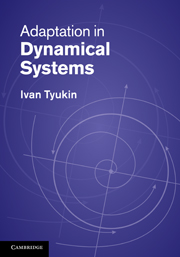3 - The problem of adaptation in dynamical systems
from Part I - Introduction and preliminaries
Published online by Cambridge University Press: 03 May 2011
Summary
In this chapter we provide an overview of mathematical formulations of the problem of adaptation in dynamical systems. Adaptation is considered here as a special regulatory process that emerges as a response of a physical system to changes in the environment. In order to understand the notion of adaptation the terms “regulation,” “response,” and “environment” need to be given some physical sense and precise mathematical definitions. Instead of inventing a new language of our own, we adopt these terms from the language of mathematical control theory. It is clear that this adoption of terms will create a certain bias in our approach. On the other hand, it will allow us to operate with rigorously defined and established objects that have already passed the test of time.
We start with a retrospective overview and analysis of main ideas in the existing literature on adaptation in the domain of control. These ideas gave rise to distinct mathematical statements of the problem of adaptation. We will discuss their strengths and limitations with respect to the demands of new real-world applications in biology, neuroscience, and engineering. As a result of the analysis, we will formulate a list of features that a modern theory of adaptation must inherit, and propose a program that will allow us to contribute to the development of such a theory in the following chapters.
Logical principles of adaptation
The theory of adaptive regulation, as a set of notions, methods, and tools for systematic study of systems adjusting their properties in response to changes in the environment, has a long history of development.
- Type
- Chapter
- Information
- Adaptation in Dynamical Systems , pp. 44 - 80Publisher: Cambridge University PressPrint publication year: 2011



